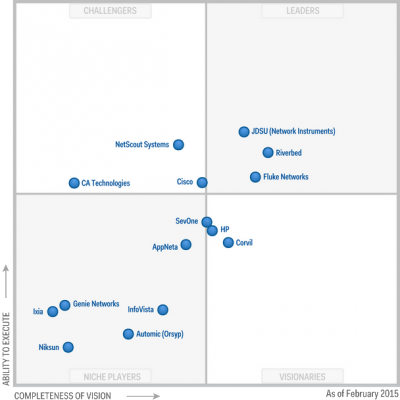Network professionals support an increasing number of technologies and services. With adoption of SDN and network function virtualization, troubleshooting becomes more complex. Identify the right NPMD tools to detect application issues, identify root causes and perform capacity planning.
Market Definition/Description
Network performance monitoring and diagnostics (NPMD) enable network professionals to understand the impact of network behavior on application and infrastructure performance, and conversely, via network instrumentation. Other users and use cases exist, especially because these tools provide insight into the quality of the end-user experience. The goal of NPMD products is not only to monitor network components to facilitate outage and degradation resolution, but also to identify performance optimization opportunities. This is conducted via diagnostics, analytics and debugging capabilities to complement additional monitoring of today’s complex IT environments. At an estimated $1.1 billion, the NPMD market is a fast-growing segment of the larger network management space ($1.9 billion in 2013), and overlaps slightly with aspects of the application performance monitoring (APM) space ($2.4 billion in 2013).
Magic Quadrant

Vendor Strengths and Cautions- Highlights
Ixia
Ixia was founded in 1997, specializing in network testing. Ixia entered the NPMD market through acquisition of Net Optics in 2013 and its Spyke monitoring product. The tool is aimed at small or midsize businesses (SMBs), although it can support gigabit and 10G environments. The Spyke tool has been subject to an end of life (EOL) announcement, with end of sale (EOS) beginning 31 October 2014, and EOL beginning 31 October 2017.
Given Ixia’s focus on the network packet broker (NPB) space, it can cover NPMD and NPB use cases, something only a few other vendors can claim. Ixia launched a new NPB platform, the Network Tool Optimizer (NTO) 7300 in 1H14, which provides large-scale chassis design and additional modules that help offload some NPMD capabilities. The goal of these modules is optimal use of the existing end-user NPMD tool. Modules include Ixia Packet Capture Module (PCM) with 14GB of triggered packet capture at 40GbE line rates and 48 ports of NPB, and the Ixia Application and Threat Intelligence (ATI) Processor, which provides extensive processing power in addition to 48 ports of NBP. The ATI Processor requires a subscription at an additional recurring cost. The new 7300 product and platform has no current Gartner-verified customer references. Fundamental VoIP, application visibility and end-user experience metrics are standard capabilities. While the tool provides packet inspection and application visibility, product updates have not been observed for some time and the road map remains unclear.
Ixia’s NPMD revenue is between $5 million and $10 million per year. Ixia did not respond to requests for supplemental information and/or to review the draft contents of this document. Gartner’s analysis for this vendor is therefore based on other credible sources, including previous vendor briefings and interactions, the vendor’s own marketing collateral, public information and discussions with more than 200 end users who either have evaluated or deployed each NPMD product.
Strengths
- Ixia’s ATI Processor provides visibility of, and rules to classify, traffic based on application types and performance of applications.
- Ixia has significant R&D resources. Of the 1,800 staff, more than 800 are engineering- and R&D-focused.
- Ixia’s market leadership in NPB allows it to leverage scalable hardware design with software capabilities to enable NPMD and additional troubleshooting needs by offloading some of these requirements from other more comprehensive NPMD tools.
Cautions
- With the EOS of the Spyke and Net Optics appTap platforms, Ixia appears to have discontinued investments in pure NPMD capabilities.
- Since the launch of the NTO 7300 platform in early 2014, there has been limited traction due to existing NPB investments and high cost for the hardware buy-in.
- Financial reporting restatements and filing delays, combined with the resignation of two senior corporate officers, may hinder overall strategic focus and vision.
JDSU (Network Instruments)
In 2014, we have witnessed the completion of JDSU’s acquisition of Network Instruments, its subsequent integration into JDSU’s Network and Service Enablement business segment, the recent release of updates to its NPMD offering, and announced plans to separate JDSU into two entities in 2015. While this action could provide additional efficiencies and focus in the future, the preceding business integration and sales enablement efforts are only now beginning to bear fruit and will have to shift once more in response to the coming changes. The Network Instruments unit has followed a well-established, vertically integrated technology development strategy, designing and manufacturing most of its product components and software. An OEM relationship with CA Technologies, which had Network Instruments providing its GigaStor products to CA customers, devolved into a referral relationship, but no meaningful challenges have been voiced by Gartner clients as a result of this. Two key parts of the NPMD solution have new product names (Observer Apex and Observer Management Server) and a new, modern UI that is a significant improvement. Network Instruments’ current NPMD solution set is now part of the Observer Performance Management Platform 17, and includes Observer Apex, Observer Analyzer, Observer Management Server, Observer GigaStor, Observer Probes and Observer Infrastructure (v.4.2).
JDSU’s (Network Instruments) NPMD revenue is between $51 million and $150 million per year.
Strengths
- Data- and process-level integration workflows are well-thought-out across the solution’s component products.
- Network Instruments’ recent addition of a network packet broker product (Observer Matrix) to its offerings may appeal to small-scale enterprises looking for NPMD and NPB capabilities from the same vendor.
- Packet capture and inspection capability (via GigaStor) is well-regarded by clients.
Cautions
- While significant business integration activities have not, to date, had a perceptible impact on support or development productivity, this process is ongoing and now part of a larger business separation action that could result in challenges in the near future.
- The NPMD solution requires multiple components with differing user interfaces that are not consistent across products.
- The solution is focused on physical appliances, with limited options beyond proprietary hardware.
To learn more, download the full report here
Thanks to Gartner for the article.







 This database contains the locations and network addresses of all hardware devices, as well as information about the programs, versions and updates installed in network computers.
This database contains the locations and network addresses of all hardware devices, as well as information about the programs, versions and updates installed in network computers.







